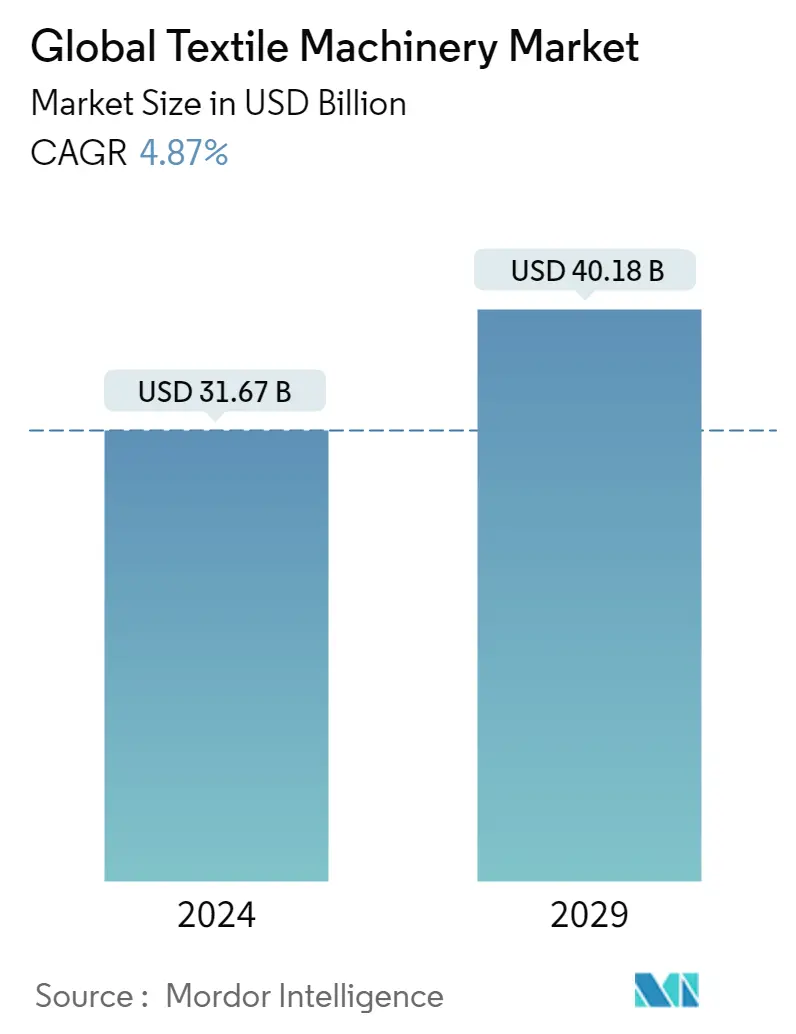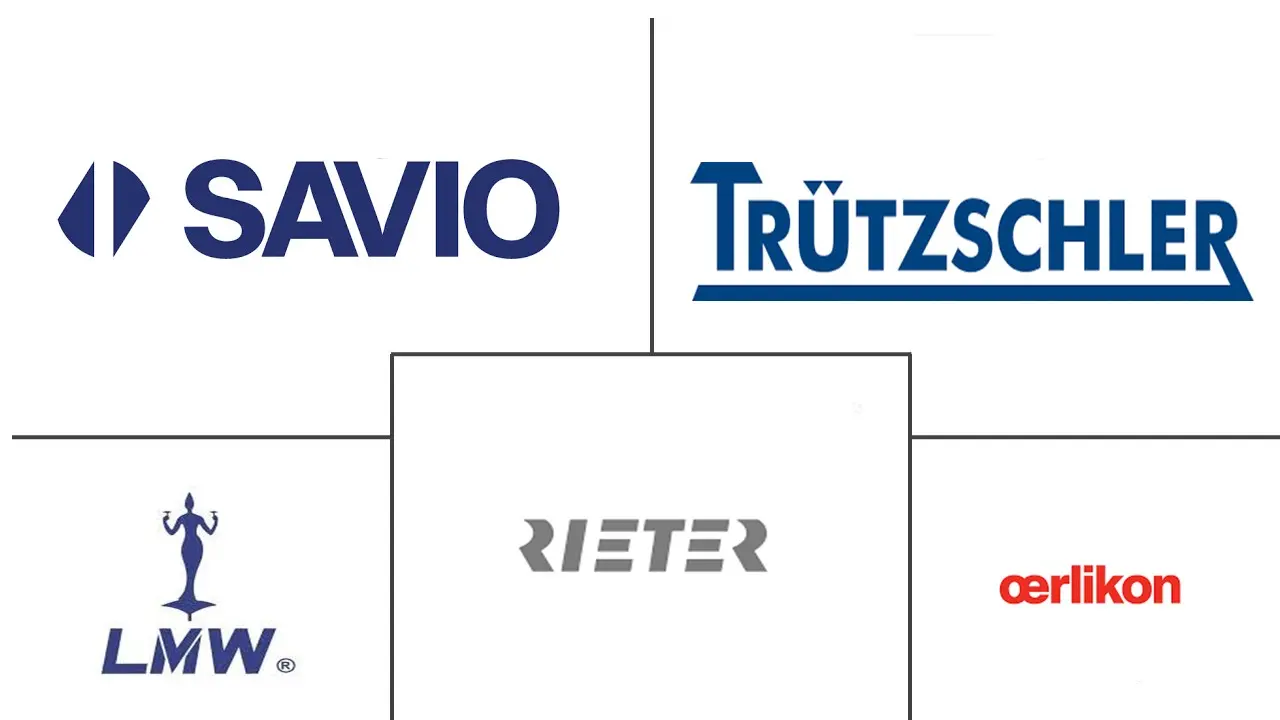Market Size of Global Textile Machinery Industry

| Study Period | 2019 - 2029 |
| Market Size (2024) | USD 31.67 Billion |
| Market Size (2029) | USD 40.18 Billion |
| CAGR (2024 - 2029) | 4.87 % |
| Fastest Growing Market | Asia-Pacific |
| Largest Market | Asia-Pacific |
Major Players
*Disclaimer: Major Players sorted in no particular order |
Textile Machinery Market Analysis
The Global Textile Machinery Market size is estimated at USD 31.67 billion in 2024, and is expected to reach USD 40.18 billion by 2029, growing at a CAGR of 4.87% during the forecast period (2024-2029).
- The increased need for sophisticated equipment that generates high-quality fabric as well as advancements in printing technology in textile production are driving market expansion. The increased use of automation and robots in textile manufacturing is also boosting the textile machinery industry.
- Machine makers now provide complex machines with increased production capacity and speed, as well as textile machinery, at cheap costs. Several small-scale market participants also help to make the machinery sector more competitive, and multinational firms have entered the global market, raising competition and forcing enterprises to improve their innovation and productivity. Because of constant technical improvements, the textile machinery industry is particularly dynamic, shifting from traditional to more complex solutions.
- While the COVID-19 situation brought problems such as shortages of raw materials, price increases, and disruptions in the supply chain, the pent-up demand during this period resulted in an increase and recovery in orders in 2021. The important and major changes created by the pandemic in daily life have also brought concepts such as sustainability, circular production, and digitalization into the focus of stakeholders investments and decisions. The world's leading textile machinery and technology manufacturers anticipate that the increasing momentum and sustainable production-oriented developments that began in 2022 will continue in 2023 and that the sector will revive with the organization of numerous international exhibitions.
Textile Machinery Industry Segmentation
Textile machines are used to make and process fabrics, clothing, and other materials. These tools are used for weaving, spinning, and dying. Textile machinery is also used to make yarn, fiber, and thread colors and finishes. Nonwovens, synthetic fibers, and a variety of polymers are also extruded with it. The textile manufacturing process includes fiber processing, yarn production, fabric production, fiber pre-treatment, dyeing and printing, and, lastly, applying finishing treatments.
The global textile machinery market is segmented by raw material (cotton, wool, nylon, polyester, acrylic, silk, and others), machine type (spinning machines, weaving machines, knitting machines, texturing machines, and others), distribution channel (direct and indirect), application (garments and apparel, household and home textiles, and technical textiles (medical, protective, sports, etc.), and geography (North America, Asia-Pacific, Europe, the Middle East and Africa, and South America). The report offers market size and forecasts for the global textile machinery market in terms of dollar value (USD billion) for all the above segments.
| By Raw Material | |
| Cotton | |
| Wool | |
| Nylon | |
| Polyester | |
| Acrylic | |
| Silk | |
| Other Raw Materials |
| By Machine Type | |
| Spinning Machines | |
| Weaving Machines | |
| Knitting Machines | |
| Texturing Machines | |
| Other Machine Types |
| By Distribution Channel | |
| Direct | |
| Indirect |
| By Application | |
| Garments & Apparels | |
| Household and Home Textiles | |
| Technical Textiles (Medical, Protective, Sports, etc.) |
| By Geography | |||||||||||
| |||||||||||
| |||||||||||
| |||||||||||
| |||||||||||
|
Global Textile Machinery Market Size Summary
The global textile machinery market is poised for significant growth, driven by the increasing demand for advanced equipment that produces high-quality fabrics and the integration of automation and robotics in textile manufacturing. The industry is characterized by rapid technological advancements, shifting from traditional machinery to more sophisticated solutions that offer enhanced production capacity and speed at competitive prices. The competitive landscape is further intensified by the presence of numerous small-scale participants and the entry of multinational companies, which have spurred innovation and improved productivity. Despite challenges posed by the COVID-19 pandemic, such as supply chain disruptions and raw material shortages, the market has shown resilience with a recovery in orders and a renewed focus on sustainability, circular production, and digitalization.
The Asia-Pacific region is expected to dominate the global textile machinery industry, with countries like India, China, and Vietnam playing pivotal roles due to their substantial textile sectors and rising demand for garments. The Indian textile machinery industry, in particular, is experiencing robust growth, supported by government initiatives and foreign direct investments aimed at modernizing the sector. The spinning machinery segment is anticipated to be the fastest-growing, driven by the demand for cotton spinning machinery in emerging markets. The market is highly competitive and fragmented, with ongoing mergers and acquisitions as companies seek to expand their geographic reach and technological expertise. Leading players in the industry include OC Oerlikon, Trützschler Group, and Lakshmi Machine Works, among others, who are actively involved in collaborations and innovations to meet the evolving demands of the market.
Global Textile Machinery Market Size - Table of Contents
-
1. MARKET INSIGHTS AND DYNAMICS
-
1.1 Market Overview
-
1.2 Market Drivers
-
1.3 Market Restraints
-
1.4 Market Opportunities
-
1.5 Value Chain / Supply Chain Analysis
-
1.6 Industry Attractiveness - Porter's Five Forces Analysis
-
1.6.1 Bargaining Power of Buyers/Consumers
-
1.6.2 Bargaining Power of Suppliers
-
1.6.3 Threat of New Entrants
-
1.6.4 Threat of Substitute Products
-
1.6.5 Intensity of Competitive Rivalry
-
-
1.7 Government Regulations and Initiatives
-
1.8 Technological Trends
-
1.9 Impact of COVID-19 on the Market
-
-
2. MARKET SEGMENTATION
-
2.1 By Raw Material
-
2.1.1 Cotton
-
2.1.2 Wool
-
2.1.3 Nylon
-
2.1.4 Polyester
-
2.1.5 Acrylic
-
2.1.6 Silk
-
2.1.7 Other Raw Materials
-
-
2.2 By Machine Type
-
2.2.1 Spinning Machines
-
2.2.2 Weaving Machines
-
2.2.3 Knitting Machines
-
2.2.4 Texturing Machines
-
2.2.5 Other Machine Types
-
-
2.3 By Distribution Channel
-
2.3.1 Direct
-
2.3.2 Indirect
-
-
2.4 By Application
-
2.4.1 Garments & Apparels
-
2.4.2 Household and Home Textiles
-
2.4.3 Technical Textiles (Medical, Protective, Sports, etc.)
-
-
2.5 By Geography
-
2.5.1 North America
-
2.5.1.1 United States
-
2.5.1.2 Canada
-
2.5.1.3 Mexico
-
-
2.5.2 Europe
-
2.5.2.1 Germany
-
2.5.2.2 France
-
2.5.2.3 United Kingdom
-
2.5.2.4 Italy
-
2.5.2.5 Spain
-
2.5.2.6 Russia
-
2.5.2.7 Rest of Europe
-
-
2.5.3 Asia-Pacific
-
2.5.3.1 China
-
2.5.3.2 Japan
-
2.5.3.3 India
-
2.5.3.4 Bangladesh
-
2.5.3.5 Turkey
-
2.5.3.6 South Korea
-
2.5.3.7 Australia
-
2.5.3.8 Indonesia
-
2.5.3.9 Rest of Asia-Pacific
-
-
2.5.4 Middle East & Africa
-
2.5.4.1 Egypt
-
2.5.4.2 South Africa
-
2.5.4.3 Saudi Arabia
-
2.5.4.4 Rest of Middle East & Africa
-
-
2.5.5 South America
-
2.5.5.1 Brazil
-
2.5.5.2 Argentina
-
2.5.5.3 Rest of South America
-
-
-
Global Textile Machinery Market Size FAQs
How big is the Global Textile Machinery Market?
The Global Textile Machinery Market size is expected to reach USD 31.67 billion in 2024 and grow at a CAGR of 4.87% to reach USD 40.18 billion by 2029.
What is the current Global Textile Machinery Market size?
In 2024, the Global Textile Machinery Market size is expected to reach USD 31.67 billion.

